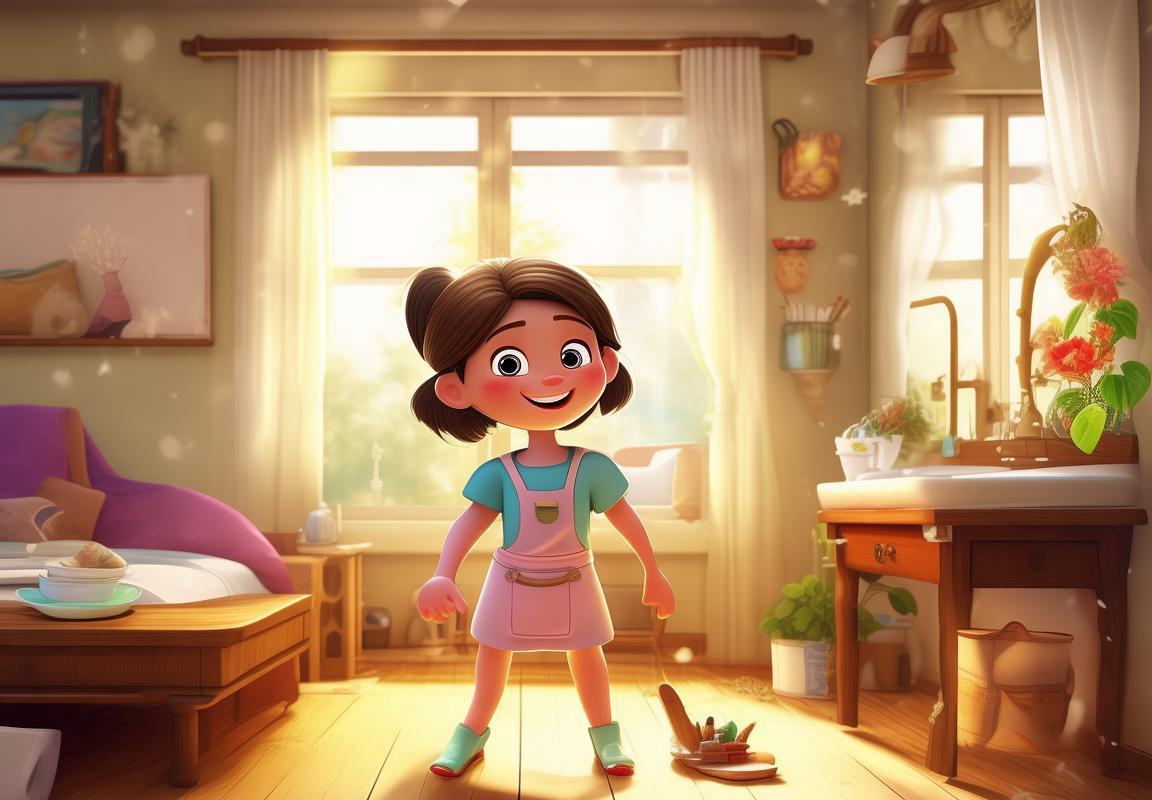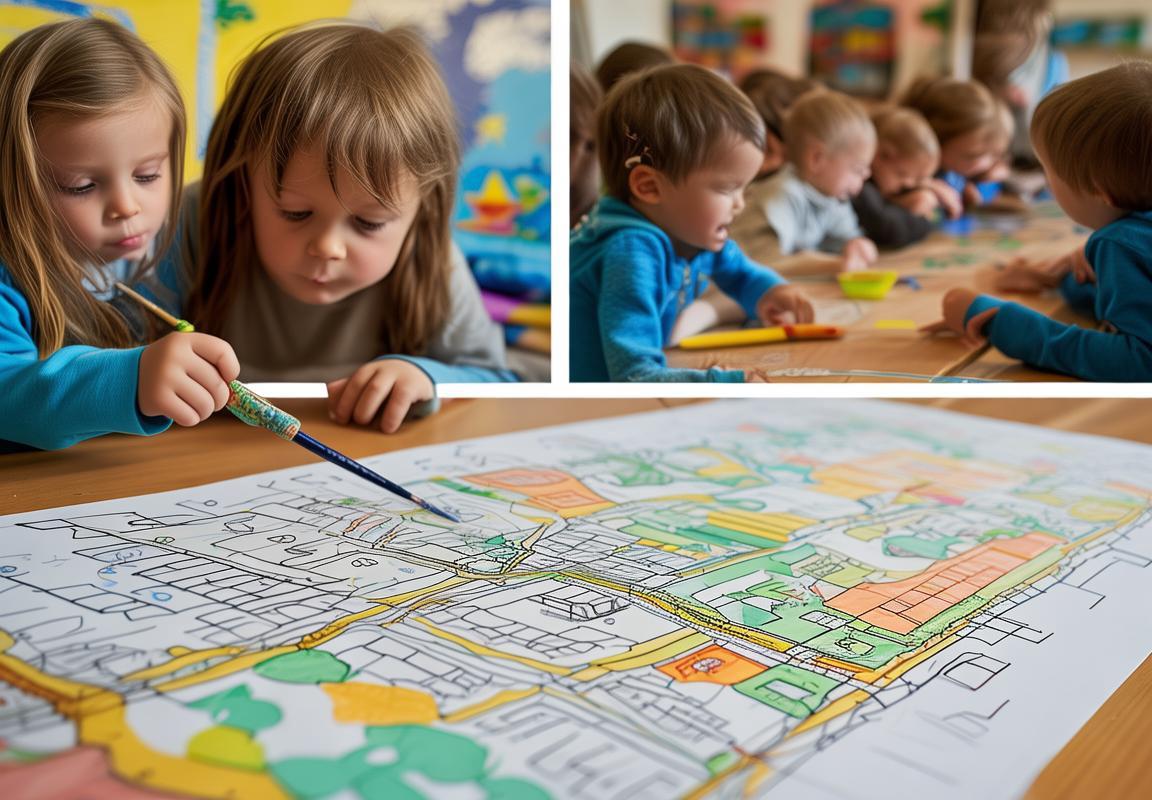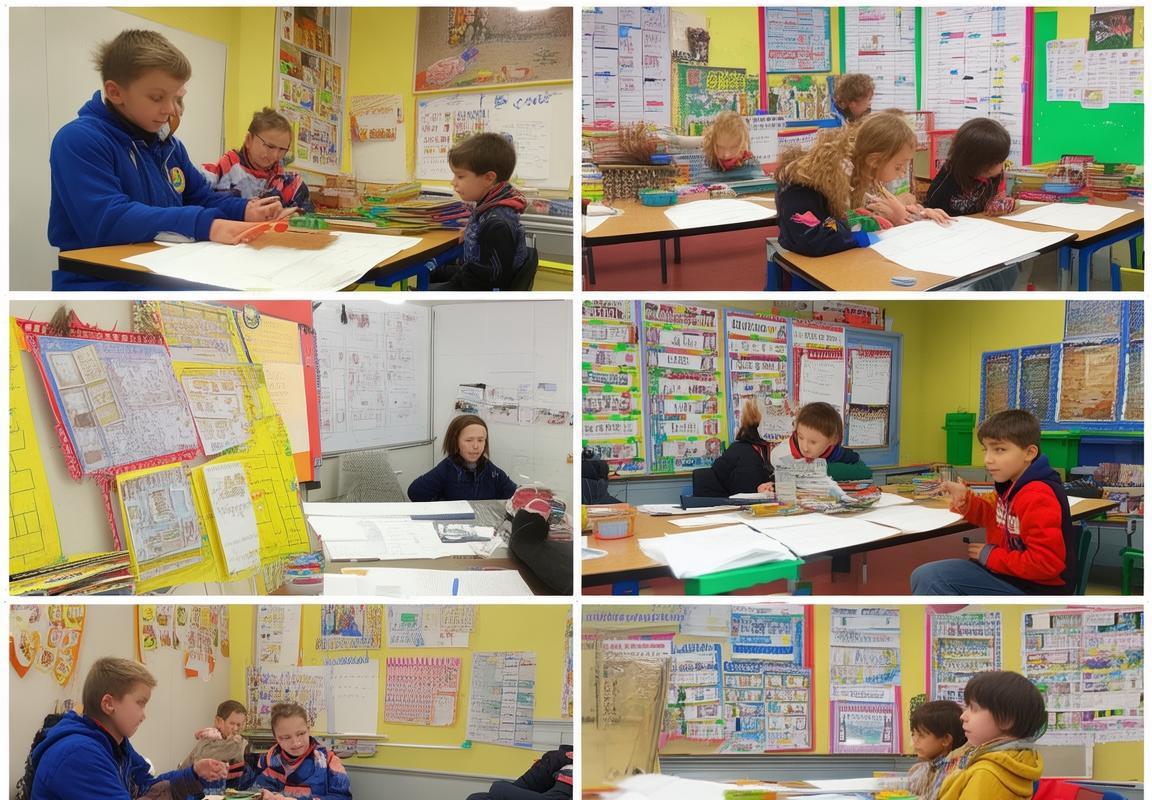เรามีรายละเอียดเกี่ยวกับเกมการจับคู่ภาษาอังกฤษกับภาพของอาหารที่เด็กชอบ โดยมีเนื้อหาเรียนรู้เกี่ยวกับภาษาอังกฤษในแบบที่ง่ายและมีสนุกสนาน ที่จะช่วยเด็กเรียนภาษาอังกฤษได้ง่ายและมีความสนุกสนานด้วยกันเป็นส่วนหนึ่งของการเรียนรู้เกี่ยวกับอาหาร และสิ่งที่เกี่ยวข้องกับมัน นี่เป็นทางเลือกหนึ่งที่เหมาะสมสำหรับเด็กที่อยากเรียนภาษาอังกฤษโดยผ่านทางการเล่นเกม โดยมีภาพที่ชัดเจนและง่ายตายที่จะช่วยเด็กหาคำศัพท์ที่ซ่อนอยู่ได้ง่าย และเพิ่มความสนุกสนานให้กับกระบวนการเรียนการเขียนภาษาอังกฤษของเด็กเล็กนี้
ภาพและคำศัพท์
เรื่องเล่าเกี่ยวกับการทำความสะอาดบ้านในภาษาอังกฤษ
Dialogue:
A: Hey, Kids! Today, we are going to have a fun story about cleaning the house. Are you ready to join me?
B: Yes! Yes! Tell us the story!
A: Once upon a time, there was a little girl named Lily. She loved her house very much, but it was getting a bit messy. So, Lily decided to clean it up herself.
B: What did she do first?
A: Lily started with the living room. She saw some dirty plates on the coffee table. She picked them up and took them to the kitchen.
B: Then what?
A: In the kitchen, Lily washed the plates with soap and water. She scrubbed them until they were sparkling clean. She put them back on the shelf.
B: Wow, that’s great! What’s next?
A: Next, Lily moved to the bedroom. She found some clothes on the floor. She picked them up and put them in the laundry basket.
B: Did she clean her bed too?
A: Yes, she did. Lily made her bed with fresh sheets and pillows. She also vacuumed the floor to make it nice and clean.
B: That’s a lot of work!
A: It is, but Lily wasn’t tired yet. She went to the bathroom next. She cleaned the toilet, sink, and shower. She even cleaned the mirror!
B: Did she do anything else?
A: After the bathroom, Lily went to the dining room. She saw some dirty dishes in the sink. She washed them and put them away.
B: Lily is really hardworking!
A: She is! And guess what? After she finished cleaning the house, her house was so clean and tidy. She felt happy and proud of herself.
B: That’s a good story! We should clean our house more often!
A: Absolutely! Cleaning can be fun if we do it together and make it a game. Remember, a clean house is a happy house!
B: Thank you for the story! We want to be like Lily and keep our house clean.
A: You’re welcome! Keep cleaning and have fun!

การเล่นเกม
เรื่องเล่าเกี่ยวกับเด็กที่ไปเที่ยวสวนสัตว์ในภาษาอังกฤษ
Once upon a time, in a small town, there was a curious little boy named Timmy. Timmy loved animals more than anything else in the world. One sunny day, he decided to visit the local zoo with his family.
As they entered the zoo, Timmy’s eyes sparkled with excitement. The first animal they saw was a towering giraffe with long, graceful necks. “Look, Mommy! It’s a giraffe!” Timmy exclaimed.
They continued their journey, and soon they met a playful monkey, which was swinging from tree to tree. “Wow, that monkey is so clever,” Timmy said, amazed by the monkey’s agility.
Next, they came across a group of colorful parrots. “Can you say hello?” Timmy asked the parrots. To his surprise, one of the parrots answered back, “Hello!” Timmy was thrilled and continued to chat with the parrots.
After that, they visited the penguins, who were waddling around in their icy habitat. “They look so cute,” Timmy said, as he watched the penguins playfully sliding on their bellies.
Timmy’s family walked through the zoo, and he learned about many different animals. He heard the lion’s roar, the bear’s growl, and the elephant’s trumpet. Each animal was more fascinating than the last.
Finally, they reached the exit of the zoo. Timmy was sad to leave, but he promised himself that he would visit again soon. As they left the zoo, Timmy felt a sense of wonder and happiness. He had spent the day surrounded by his favorite creatures, and it was one of the best days of his life.
And so, the story of Timmy’s visit to the zoo came to an end. But the memory of that day would stay with him forever, reminding him of the magic of animals and the joy of discovery.

กิจกรรมเสริม
1. การดึงและแอบซ่อน
- กติกาเกม: ให้เด็กดึงภาพที่มีคำศัพท์ซ่อนอยู่และแอบซ่อนในห้องหรือสวนที่เป็นที่รู้จักของพวกเขา แล้วให้เพื่อนร่วมเล่นหาคำศัพท์ที่ซ่อนอยู่。
- หน้าที่เล่น: สามารถเลือกห้องหรือสวนเป็นที่ซ่อนภาพ และให้เด็กจัดการแบบเลือกของตัวเองเพื่อเพิ่มความสนุกสนานและความท้าทายของเกม。
- ประโยชน์: การดึงและแอบซ่อนช่วยเด็กพัฒนาทักษะการสร้างแผนและความสำนึกในการหาสิ่งที่ซ่อนอยู่。
2. การวาดภาพ
- กติกาเกม: ให้เด็กวาดภาพของสิ่งแวดล้อมที่พวกเขารู้จักและซ่อนคำศัพท์ที่เกี่ยวข้องในภาพดังกล่าว หลังจากนั้นให้เพื่อนร่วมเล่นหาคำศัพท์ที่ซ่อนอยู่。
- หน้าที่เล่น: สามารถให้เด็กวาดภาพของที่อยู่อาศัยของตนเองหรือสถานที่ที่พวกเขาชื่นชอบ แล้วให้เพื่อนร่วมเล่นหาคำศัพท์ที่ซ่อนอยู่ในภาพดังกล่าว。
- ประโยชน์: การวาดภาพช่วยเด็กพัฒนาทักษะการวาดและความสร้างสรรค์ของตนเอง นอกจากนั้นยังช่วยเพิ่มความสนุกสนานในการเล่นเกมด้วย。
3. การประเมินผล
- กติกาเกม: ให้คะแนนตามจำนวนคำศัพท์ที่เด็กหาได้ถูกต้องในแต่ละภาพ โดย 5 คะแนนสำหรับคำศัพท์ทั้งหมดที่ซ่อนอยู่ และ 0 คะแนนสำหรับไม่หาได้คำศัพท์ใดแม้แต่หนึ่งคำศัพท์。
- หน้าที่เล่น: ให้เด็กแสดงผลการหาคำศัพท์และคะแนนของตนเอง แ

การประเมินผล
- การหาคำศัพท์ซ่อน: ให้เด็กหาคำศัพท์ที่ซ่อนอยู่ในภาพและประเมินผลจากจำนวนคำศัพท์ที่หาได้ถูกต้อง。
- การจับคู่: ให้เด็กจับคู่คำศัพท์กับภาพที่เกี่ยวข้อง และประเมินผลจากความแน่ใจและความเร็วของการจับคู่。
- การประเมินผลทางการเขียน:
- การเขียนภาษาอังกฤษ: ให้เด็กเขียนคำศัพท์หรือประโคนที่เกี่ยวข้องกับสิ่งแวดล้อม และประเมินผลจากความถูกต้องของภาษาและความคล่องแคล่วของตัวอักษร。
- การประเมินผลทางการอ่าน:
- การอ่านภาษาอังกฤษ: ให้เด็กอ่านประโคนหรือคำศัพท์และประเมินผลจากความถูกต้องของภาษาและความเร็วของการอ่าน。
- การอ่านเรื่องราว: ให้เด็กอ่านเรื่องราวและประเมินผลจากความเข้าใจของเนื้อหาและความสามารถในการกล่าวออกเรื่องราวที่เกี่ยวข้อง。
- การประเมินผลทางการสื่อสาร:
- การสนทนา: ให้เด็กเข้าร่วมการสนทนาในภาษาอังกฤษ และประเมินผลจากความเข้าใจของเนื้อหาและความสามารถในการตอบคำถามหรือเสริมเพิ่มเติมเรื่องราว。
- การแข่งขันตอบคำถาม: ให้

รางวัล
- ให้รางวัลสำหรับเด็กที่ทำได้ดีที่สุดในแต่ละกิจกรรมเรียนรู้ อาจเป็นของขวัญเล็กๆ เช่นหมายเล็ก, บล็อกแบบ, หรือซองของเงินเล็กๆ ที่มีสีสวยงาม และมีสัญลักษณ์ที่เป็นสัญาณว่าเด็กได้ทำได้ดีแล้ว。
- รางวัลอุดมคติ:
- ให้รางวัลสำหรับเด็กที่มีความคิดและความคิดสร้างสรรค์ อาจเป็นรางวัลเช่นสมุดหรือหนังสือเรื่องราวที่มีภาพสวยงาม หรือเครื่องเล่นที่ช่วยในการเรียนเรียกเล่าคำศัพท์และคำวรรณ์。
- รางวัลความยึดมั่น:
- ให้รางวัลสำหรับเด็กที่มีความยึดมั่นและมุ่งมั่นในการเรียน อาจเป็นรางวัลเช่นเหรียญทองหรือเหรียญเงินที่มีภาพสัญลักษณ์ของการเรียนรู้และการเรียนภาษาอังกฤษ。
- รางวัลความสำเร็จ:
- ให้รางวัลสำหรับเด็กที่ได้คะแนนสูงสุดในการแข่งขันหรือกิจกรรมเรียนรู้ อาจเป็นรางวัลเช่นตัวเลขหรือภาพที่มีภาพสัญลักษณ์ที่แสดงถึงความสำเร็จของการเรียนรู้และการเรียนภาษาอังกฤษ。
- รางวัลความสนใจ:
- ให้รางวัลสำหรับเด็กที่มีความสนใจในการเรียนและมีความยอมรับต่อการเรียนรู้ อาจเป็นรางวัลเช่นหนังสือเรื่องราวที่มีภาพสวยงาม หรือเครื่องเล่นที่ช่วยในการเรียนเรียกเล่าคำศัพท์และคำวรรณ์。
เหล่าเด็กที่ได้รับรางวัลจะมีโอกาสแสดงความสำเร็จของตนเองต่อเพื่อนๆ และมีโอกาสเพิ่มความยอมรับและการช
